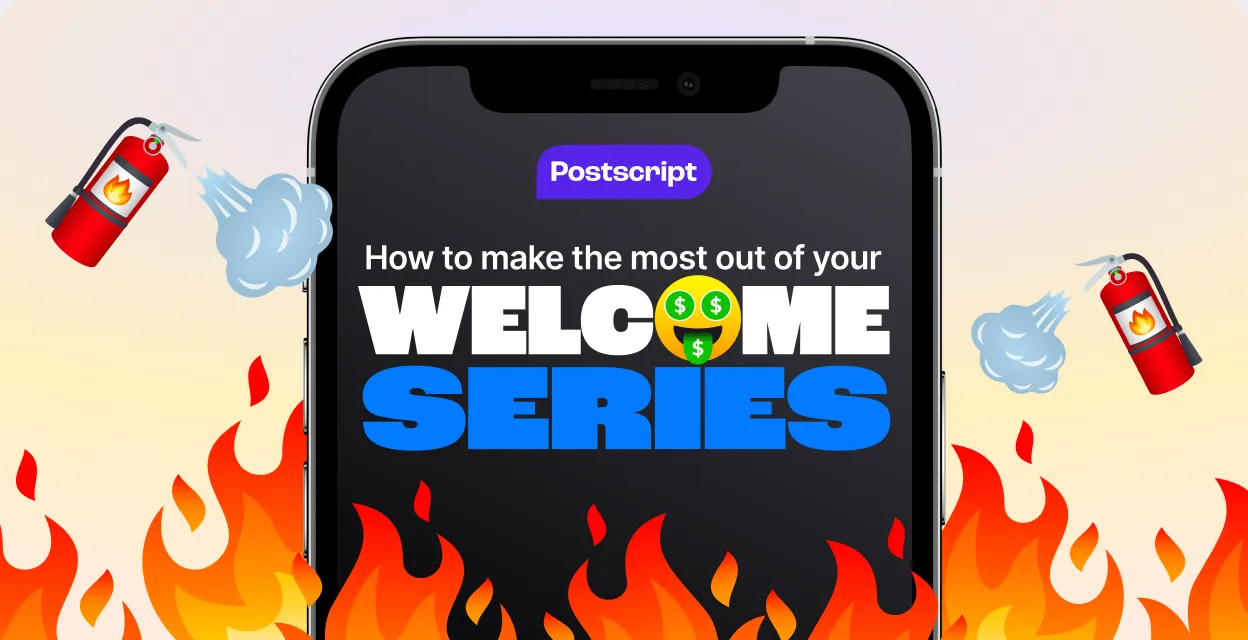
Your SMS Welcome Series, 4 Ways: How to Retain and Convert Subscribers
Quick poll: When a subscriber opts into your SMS program, do you send them a message right away?
If you said yes, we’re giving you a round of applause. If you fell into the “no” bucket, that’s okay—but let’s talk about why it’s crucial to fire off that welcome series as soon as a new subscriber joins your list.
Unlike email subscribers, we found that SMS subscribers are more likely to unsubscribe within the first 30 days of signing up for messages than they are at any other point of the subscriber lifecycle.
That means the rules of engagement are simple: send them a message right away. The faster you engage with them or get them to purchase, the more likely they are to stay on your list and become a loyal customer.
But not all welcome series are created equal. An automated “Here’s 10% off your first order” might turn a quick ROI, but it doesn’t guarantee someone will become a brand enthusiast or even bother to purchase again. Once they’ve used the introductory discount, they might figure there’s no point in sticking around—unless you set clear expectations for just how rad your SMS program is.
With that in mind, here’s how to set up a killer welcome series to hook and retain subscribers for the long haul.
Approach #1: Discount
The classic give and take. If someone is willing to offer up their personal phone number, you may be inclined to give them a discount in return.
There are a lot of ways to go this route. If you’re offering a 10% off code in a subscription popup, it’s crucial that you serve it up to subscribers immediately in a text.
But then what? Here’s where you’ve got an important opportunity to educate and engage your subscriber over a series of subsequent texts—whether or not they buy (that part is up to you).
Let’s take a look at an example. Clothing brand Soft Serve offers a 15% discount on your first order when you join their SMS list.

If a subscriber purchases from the first text, they’re automatically opted out of the welcome series since they’ve already converted. But if not, they receive a mix of content and promo code reminders over the next 3 days.
Here’s a few of the texts from that series.

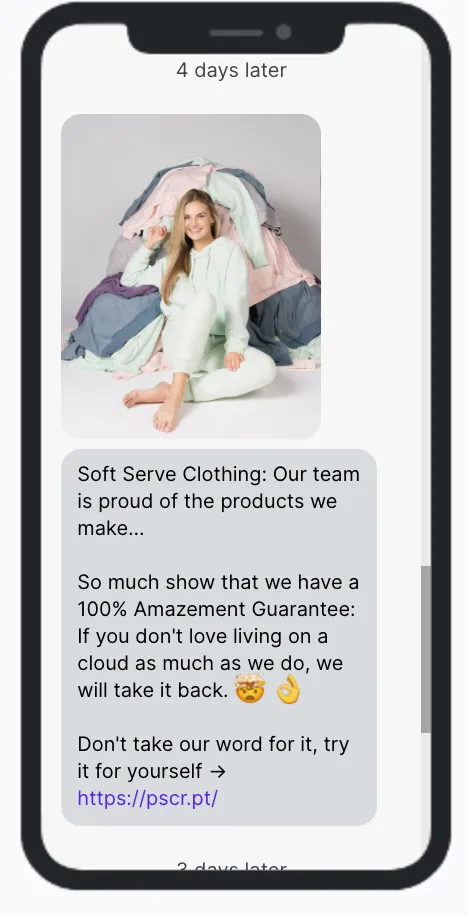
New subscribers are introduced to Soft Serve as a sustainable brand that takes their commitment to quality and customer satisfaction very seriously.
They use their brand’s story—with incentives to buy sprinkled in—to convert those subscribers.
If you really want to optimize the discount approach, don’t forget to send reminders—and make sure subscribers know there is a limited window of time for them to use their discount.
Beauty brand Kopari uses a two-text welcome series that gives subscribers their discount code the moment they opt-in. Those who do not purchase right away receive a reminder text the next day nudging them to use their code before it expires.

Here’s the tl;dr for the discount approach:
If you’ve promised a discount, deliver it right away.
Pepper in at least one reminder before it expires.
Include a story about your brand within your welcome series.
Approach #2: Branding
Discount incentives are super common in SMS, but do you actually need to offer a discount to get subscribers to opt in? That depends on your brand—and it’s why we always suggest split-testing different offers.
If you decide not to sling a discount code in exchange for a phone number—but you’re still collecting a decent volume of new subscribers—that means one very important thing: they’re truly high-intent subscribers. They don’t need a discount to want to hear from you. They just love you! This is a huge opportunity to capitalize on as a brand.
Brightland, for example, very rarely discounts their products, so they do not offer a discount for new subscribers.
Here’s a peek at what they offer instead.
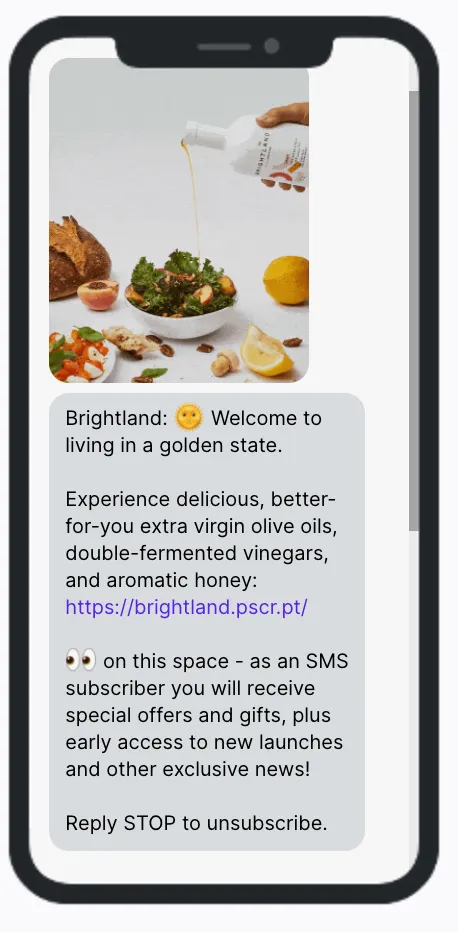
Brightland uses SMS as an exclusive space for the most loyal of fans. Their first welcome series message gives a taste of what one can expect as a subscriber, and then they serve up a second message that promotes a product.
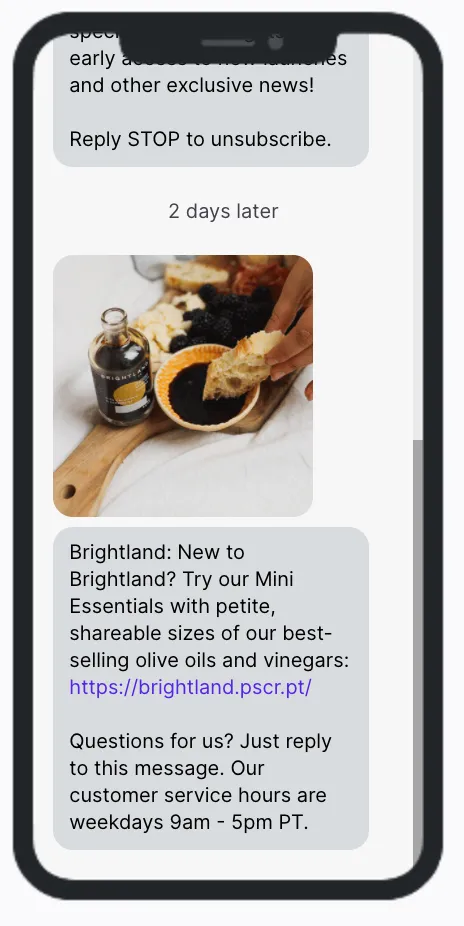
This message offers subscribers the chance to sample Brightland’s entire line with a gateway product—something that’s low cost and easy to “add to cart.” They also open themselves up for any questions that a subscriber might have.
If your brand has a bestselling product or offering that might incentivize someone to give you a try, this is a solid approach for new subscribers.
We also always recommend using your welcome series to remind subscribers that they can text you back. For some, SMS is still new, and they need to be told how they can use the channel to interact with their favorite brands.
Pizza oven brand Gozney takes a similar approach. They have a 5-message welcome series with no discount codes or promotions. They use a branded flow that’s fun, engaging, and— dare we say it—delish.
Here’s a peek at some of the messages they serve up.
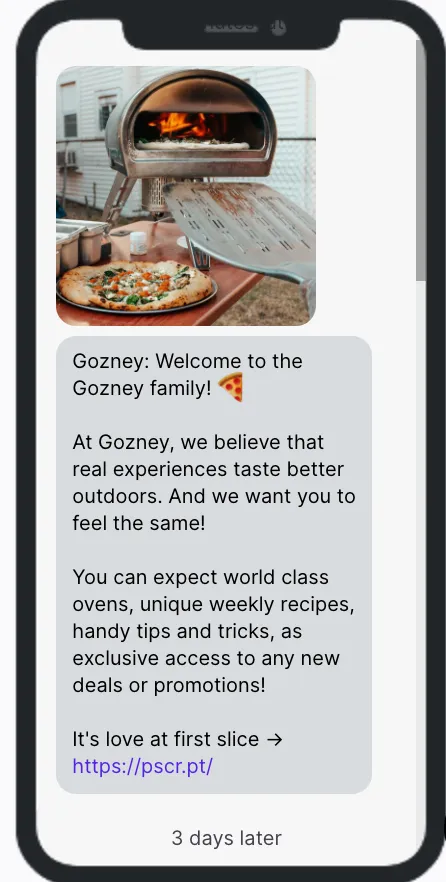
It’s always smart to explain what subscribers can expect to receive in their inbox within that very first message—even if it’s coupled with a promotion.
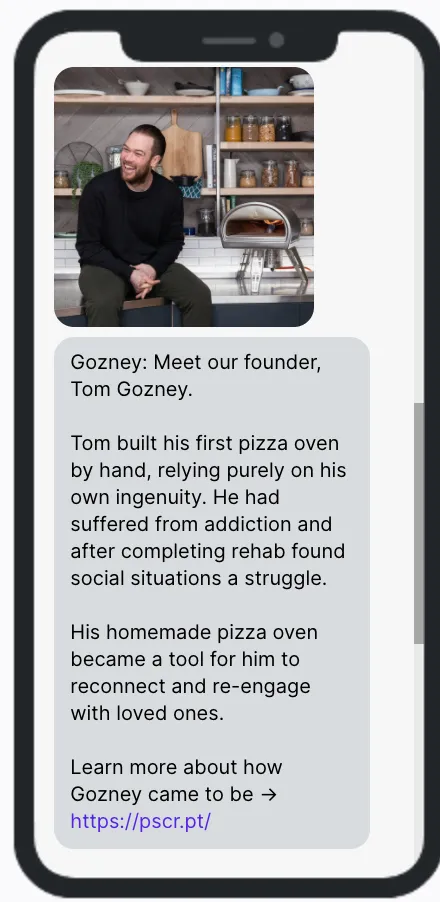
Founder stories are such an underutilized welcome series strategy. Not only are these intros an opportunity to get personal with subscribers—as Gozney’s founder does—but they’re also a nice way to nudge subscribers to learn more without strongly pushing them to buy.
If you do choose to share something personal, throw a question back out into the ether for subscribers to engage with and see how it performs. It could be a great way to connect with new subscribers early on in their journey.
Here’s the tl;dr for the branding approach:
Test your offers.
Tell your brand story.
Include a message from the founder.
Approach #3: Keywords
We know keywords are a big deal when it comes to acquisition. In our 2022 Benchmarks report, we found that Keyword Opt-in messages generated the highest EPM (Earnings per Message) and also showed the highest CTR (Clickthrough Rate) and Conversion Rate of all message types.
You should absolutely be using keywords to acquire subscribers—and to strategically segment those subscribers post-acquisition.
This allows you to make sure you’re targeting each subscriber with the exact type of texts they want to receive. You can ask them if they only want promotional messages or if they’d like to receive everything. You can even drill down and segment them based on their interests within your brand categories.
Here’s a few examples of brands on Postscript doing this well.
Branch specializes in office furniture. In their first message to subscribers, they offer a keyword reply to segment them based on their biggest interests:

When a subscriber responds, Branch can instantly add them into the appropriate segments so they only receive messages relevant to their needs (and therefore are less likely to opt out).
Tower Records takes a similar approach with their welcome flow. Their keyword reply allows subscribers to create a personalized experience with recommended music picks based on their responses.
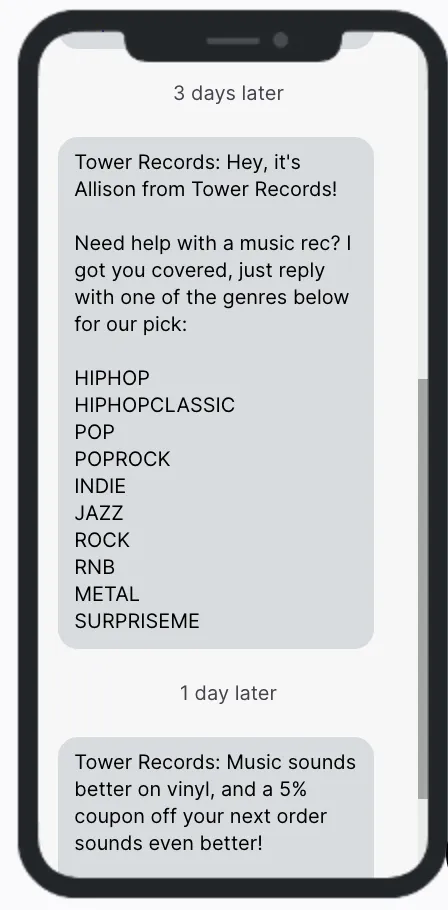
Here’s the tl;dr for the keywords approach:
Think about which keywords are most impactful for your customers, and let new subscribers opt into segments using the ones that best fit the messages they want to receive.
Approach #4: Text Us Back
One of the best ways to make a lasting impact on a new subscriber is giving them the chance to strike up a real 1:1 conversation.
So, use your welcome series to let them know that they can text you back.
A lot of brands do this by creating an experience where subscribers feel as if they are texting directly with a cofounder.
And of course, we’ve got plenty of integrations so you can make sure your support team is ready to field and respond to texts as they roll in.
DBL Jewelry positions their main personality—and thus their personality—front and center with their welcome series.
First up, meet their founder!
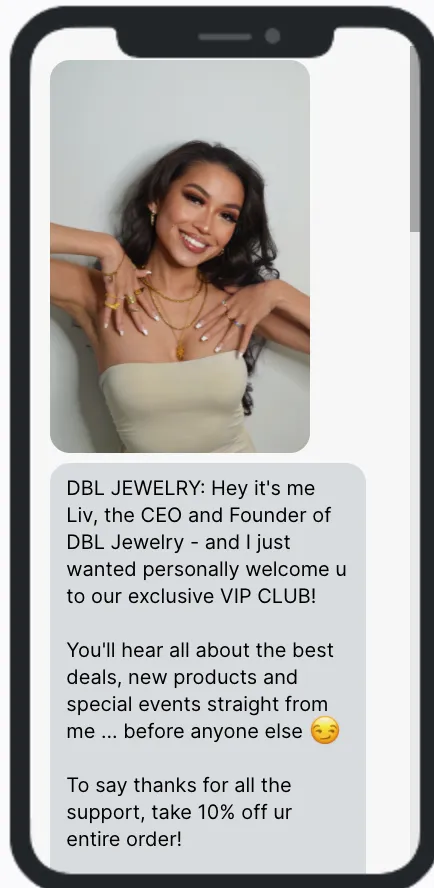
New subscribers hear from Liv throughout the welcome series, including this text where they have the opportunity to get jewelry suggestions from the founder herself.
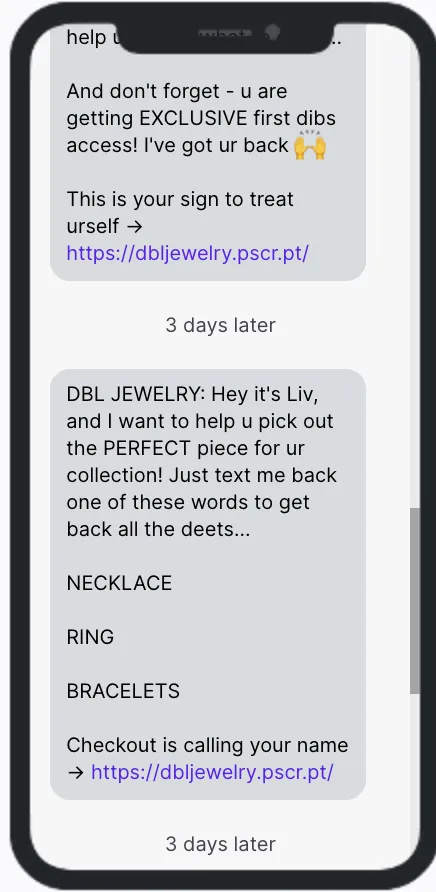
Although the resulting follow-ups are automated through keyword responses, it still offers a personal touch and a way to find out exactly what kind of jewelry a new customer is looking for. This makes it easier to target them with optimized campaigns later in the customer journey.
Beauty brand Three Ships also takes a super personalized approach where they not only introduce keywords as a way to further segment subscribers, but also directly invite subscribers to text them back.
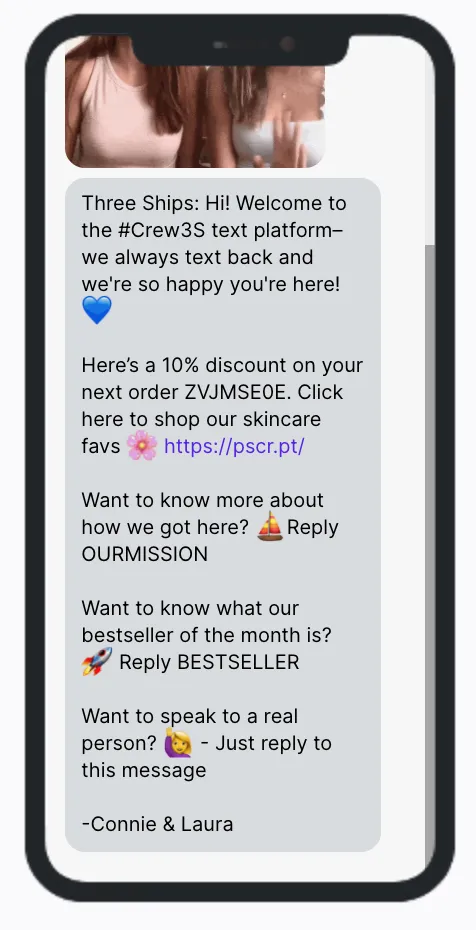
Clothing brand Freedom Rave Wear has a personal message from their founder that reads just like a friend sending a text. New subscribers feel like they can hit her up with any questions and receive get a direct response.
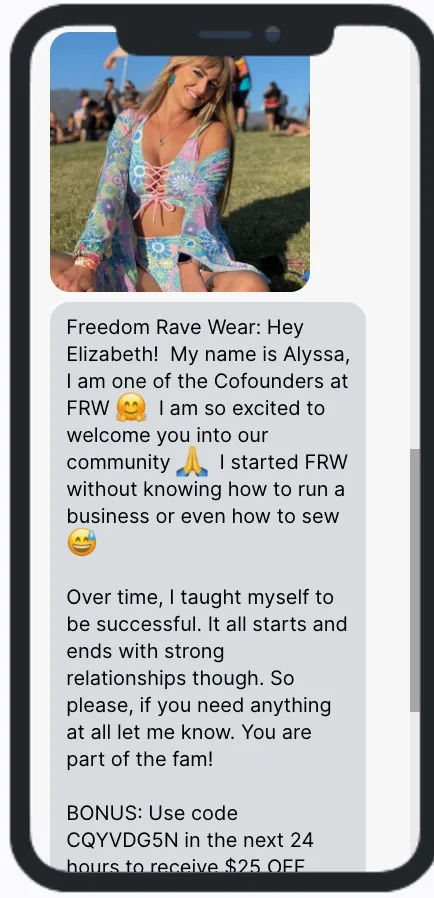
Wouldn’t it be nice to have your favorite beauty brand’s CEO in your pocket? That’s exactly what Aisling Organics promises in their first welcome series message.
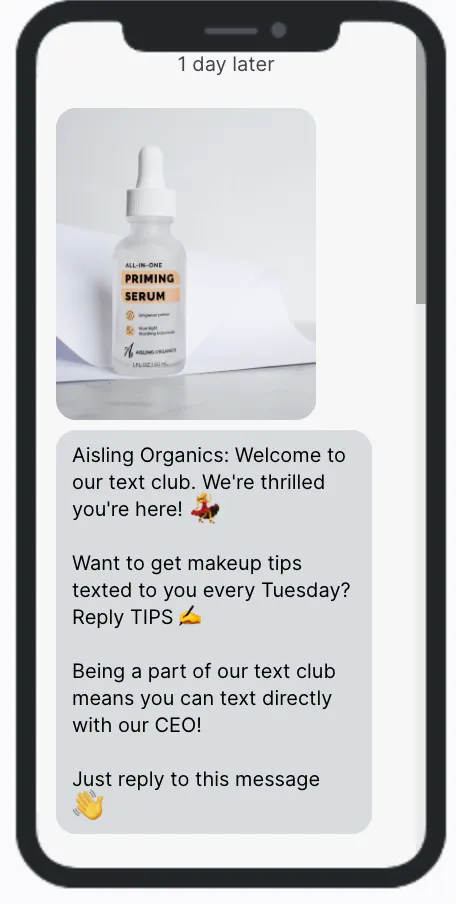
Here’s the tl;dr for the text us back approach:
Encourage customers to text back by introducing yourself or someone from your brand.
Get personal or provide a prompt to get new subscribers to engage with you early in their journey.
We talk a lot about the importance of keeping unsubscribes low if you want to maintain a strong Subscriber LTV (learn more about that here), and engaging with new subscribers is crucial to keeping your list healthy.
Now that you know how to create a killer welcome series, test out these strategies with your new subscribers. And here's how to create one right in Postscript.



